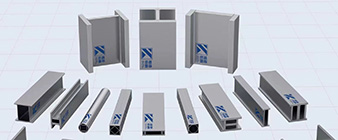S32205 (2205) and UNS S31803 (2203) duplex stainless steels have some overlapping applications, but their specific properties make them suitable for different industries and environments. The following are typical applications for each grade:
Offshore and marine environments:
Offshore oil and gas platforms
Subsea equipment and pipelines
Desalination plants and seawater intake systems
Coastal and port infrastructure (e.g. piers, docks, breakwaters)
Chemical and Petrochemical Processing:
Containers, tanks and piping for chemical plants
Equipment for handling corrosive chemicals and corrosive liquids
Refineries and petrochemical facilities
Pulp and Paper Industry:
Digesters, evaporators and other process equipment
Pipes and valves for pulp and paper mills
Water and wastewater treatment:
Desalination plant components
Wastewater treatment equipment
drinking water distribution system
Power generation:
Nuclear power plant components
Coal-fired power plant flue gas desulfurization system
Geothermal power plant equipment
General industrial applications:
Process equipment, storage tanks and pipelines for various industries
Architectural and decorative elements
Household appliances and kitchen equipment
Food and Beverage Processing:
Equipment, tanks and piping for food, dairy and beverage plants
Food processing machinery and equipment
Pharmaceutical and Biomedical:
Medical equipment, surgical equipment and laboratory equipment
Pharmaceutical processing equipment
Low and high temperature applications:
Liquefied Natural Gas (LNG) Facilities
Petrochemical plants and power generation equipment
S32205 is the first choice for more corrosive and demanding environments, such as the offshore, chemical and water treatment industries, where its superior corrosion resistance and mechanical properties are critical.
S31803 is more commonly used in general industrial, food and beverage, and pharmaceutical applications, where its slightly lower corrosion resistance and mechanical properties are acceptable, and its lower cost is an advantage.
-
 2024-9-25 Stainless Steel 430/1.4016 Structural Profiles
2024-9-25 Stainless Steel 430/1.4016 Structural Profiles -
 2024-9-21 Effective design and construction of high-strength S690 steel
2024-9-21 Effective design and construction of high-strength S690 steel -
 2024-9-29 Alloy 617 (N06617 / 2.4663) Hollow Structural Profiles
2024-9-29 Alloy 617 (N06617 / 2.4663) Hollow Structural Profiles -
 2024-9-24 S690 Structural Section-Universal Bearing Piles
2024-9-24 S690 Structural Section-Universal Bearing Piles -
 2024-9-29 Alloy 602 CA / 2.4633/N06025 Nickel-based alloy structural profiles
2024-9-29 Alloy 602 CA / 2.4633/N06025 Nickel-based alloy structural profiles -
 2024-9-25 SMO254 Super Stainless Steel for Structural Applications
2024-9-25 SMO254 Super Stainless Steel for Structural Applications -
 2023-12-12 Stainless steel laser welding profile knowledge
2023-12-12 Stainless steel laser welding profile knowledge



